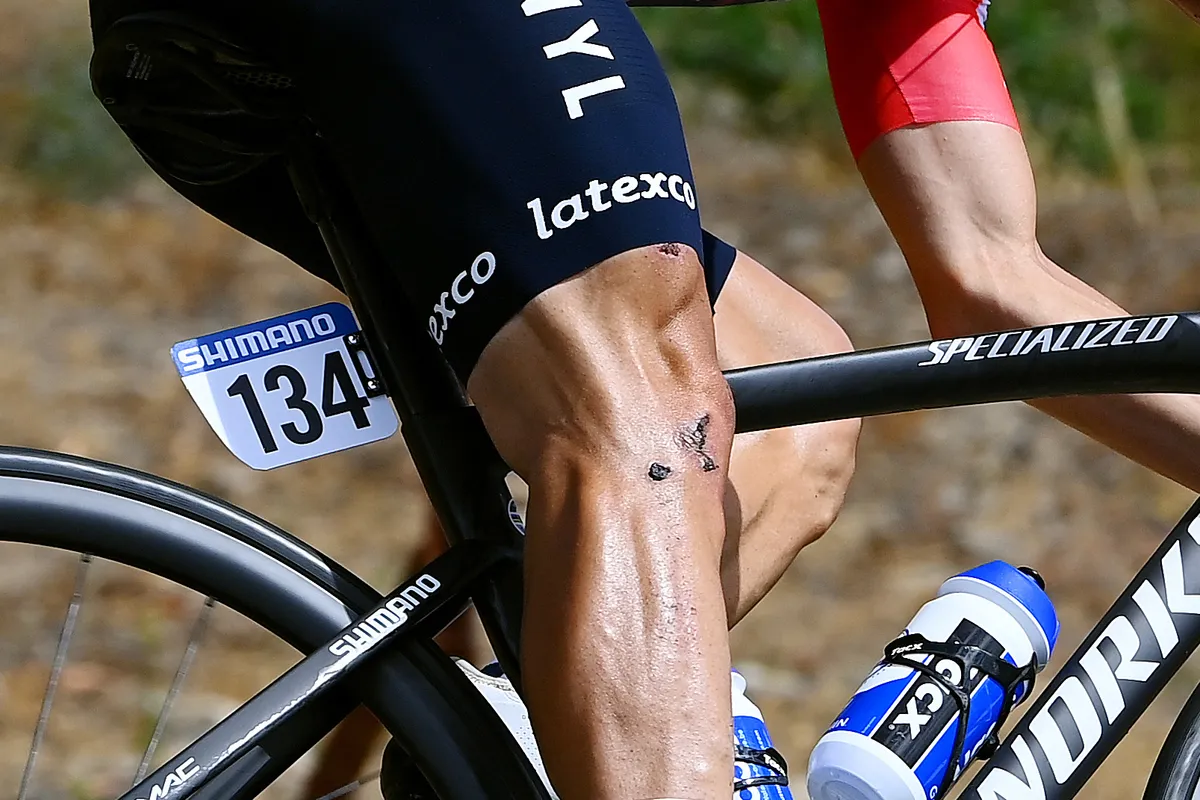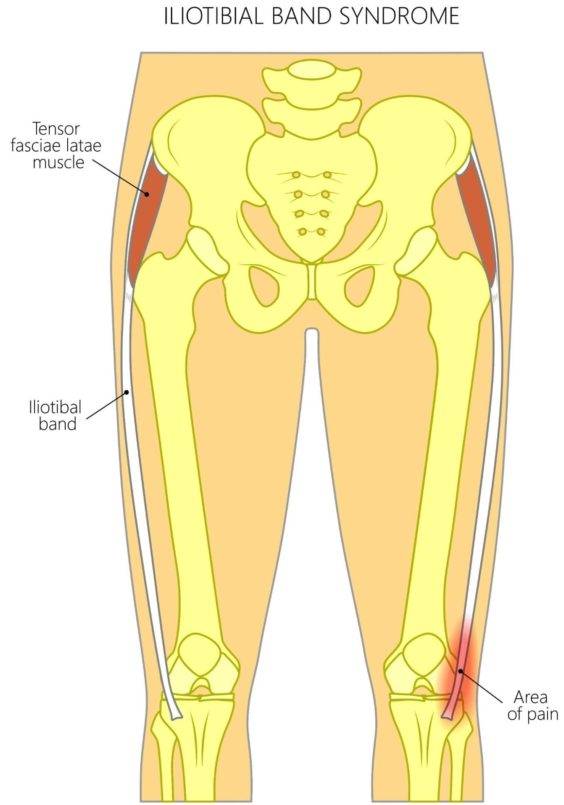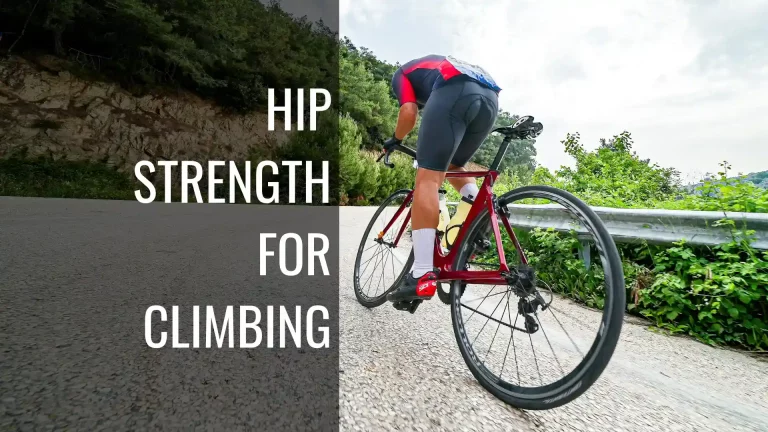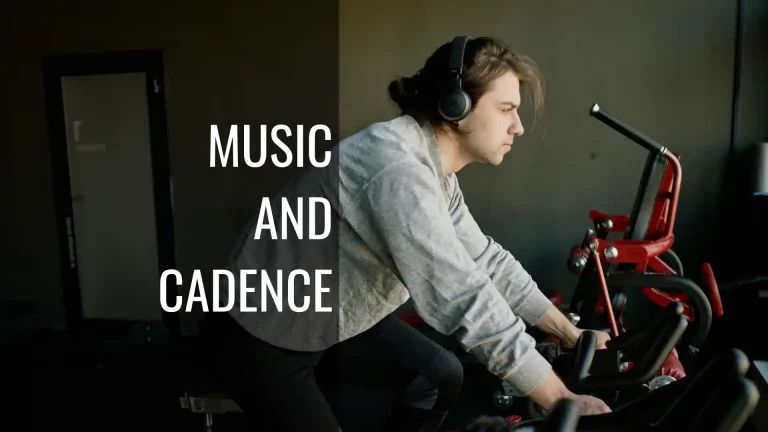
Iliotibial (IT) Band pain and Iliotibial Band Syndrome (ITBS) is a common overuse injury among cyclists, causing lateral knee pain and discomfort. The IT band, a thick band of connective tissue that runs from the hip to the knee, plays a crucial role in stabilizing the knee during the repetitive motion of cycling. When the IT band becomes tight or inflamed, it can rub against the knee joint, leading to irritation, swelling, and pain. Several factors contribute to ITBS in cyclists, including improper bike fit, muscle imbalances, poor cycling technique, and a sudden increase in training volume or intensity.
In this blog post, we will delve into the causes, symptoms, and effective strategies to address ITBS, ensuring that you can pedal your way to a pain-free and enjoyable cycling experience.
Table of Contents
Iliotibial (IT) Band - What It Does
The iliotibial (IT) band is a thick, fibrous band of connective tissue that plays a crucial role in the stability and function of the lower extremities, particularly during activities such as running and cycling. It originates from the tensor fasciae latae (TFL) muscle in the hip and extends down the outer thigh, attaching to the lateral aspect of the knee joint.
The primary functions of the IT band include:
- Stabilizing the Knee: The IT band helps stabilize the knee joint by providing lateral support and resisting excessive inward (medial) movement of the knee during weight-bearing activities.
- Assisting Hip Abduction: In conjunction with the TFL and other hip abductor muscles, the IT band contributes to moving the leg away from the body, which is essential for walking, running, and maintaining balance.
- Shock Absorption: The IT band helps absorb shock and distribute forces between the hip and knee during impact activities such as running, reducing stress on the joints and minimizing injury risk.
- Facilitating Efficient Movement: By providing a stable connection between the hip and knee, the IT band allows for efficient transfer of forces between the lower extremities during walking, running, and cycling.
When the IT band becomes tight, inflamed, or overused, it can lead to iliotibial band syndrome (ITBS), characterized by pain and tenderness on the outer knee. Proper stretching, foam rolling, strengthening exercises, and addressing biomechanical issues can help prevent and manage ITBS, ensuring optimal performance and comfort during physical activities.

What is Iliotibial (IT) Band Sydrome?
Iliotibial Band Syndrome (ITBS) is a common overuse injury characterized by inflammation and pain in the iliotibial band (IT band), a thick band of connective tissue that runs along the outer thigh from the hip to the knee. ITBS typically results from repetitive friction between the IT band and the bony structures of the knee joint, particularly during activities like running, cycling, and hiking.
The primary symptoms of ITBS include:
- Lateral Knee Pain: Pain or discomfort on the outer side of the knee is the most common symptom of ITBS. The pain may be sharp or stabbing, and it often worsens with continued activity.
- Swelling and Tenderness: The area around the knee where the IT band attaches may become swollen and tender to the touch.
- Pain with Specific Movements: Pain may worsen when bending the knee past 30 degrees, such as during squatting, stair climbing, or running downhill.
- Snapping Sensation: Some individuals may experience a snapping or popping sensation at the knee as the IT band rubs over the bony structures of the joint.
The development of ITBS can be attributed to several factors, including:
- Overuse and Repetitive Stress: Repetitive stress on the IT band from activities like running, cycling, or other sports can lead to inflammation and irritation.
- Biomechanical Issues: Factors such as leg length discrepancy, poor foot arch support, or excessive pronation can contribute to ITBS by altering the alignment and forces on the knee joint.
- Inadequate Stretching and Flexibility: Tightness in the IT band, hip flexors, or quadriceps muscles can increase stress on the knee joint and contribute to the development of ITBS.
- Muscle Imbalances: Weakness or imbalances in the hip abductor and gluteal muscles can cause the IT band to overcompensate, increasing the risk of ITBS.
Treatment for ITBS typically involves rest, icing the affected area, anti-inflammatory medications, and stretching and strengthening exercises targeting the IT band, hip abductors, and glute muscles. Addressing biomechanical issues, such as improving foot arch support, and modifying training regimens to reduce overuse can help prevent the recurrence of ITBS.
Signs It's Time to Rest Your Knees When Cycling
Listening to your body and recognizing the signs of knee fatigue or overuse is crucial for preventing injuries and maintaining long-term performance in cycling. Here are some indicators that it may be time to rest your knees and allow them to recover:
- Persistent Pain or Discomfort: If you experience consistent pain or discomfort in your knees during or after cycling, it’s a clear sign that your knees need rest. Ignoring persistent pain can lead to more severe injuries.
- Swelling or Inflammation: Visible swelling or inflammation around the knee joint is a strong indication that you need to rest and recover. This may be a sign of an underlying issue such as tendonitis, bursitis, or other inflammatory conditions.
- Decreased Performance: If you notice a decline in your cycling performance, such as reduced power output or endurance, it may be a sign that your knees are fatigued and in need of rest.
- Stiffness or Reduced Range of Motion: If your knees feel stiff or you experience difficulty bending or straightening them fully, it could be a sign of overuse or a developing injury.
- Instability or Giving Way: If your knees feel unstable or give way during cycling or other activities, it’s essential to rest and consult a healthcare professional to determine the underlying cause.
- Cracking, Popping, or Grinding Sensations: Unusual sounds or sensations in your knees during cycling can indicate cartilage damage or other joint issues that require rest and attention.
If you experience any of these signs, it’s essential to rest your knees, ice the affected area, and consider seeking professional medical advice. Additionally, addressing underlying issues like bike fit, muscle imbalances, or training volume can help prevent future knee problems and keep you pedaling comfortably and efficiently.
Treatment Options for Iliotibial (IT) Band Pain
If you’re experiencing iliotibial band (IT) pain, several treatment options are available to help alleviate discomfort and promote healing. Here are some approaches to consider:
- Rest and Ice Therapy: Resting the affected leg and applying ice to the area can help reduce inflammation and pain. Apply ice for 15-20 minutes, several times a day, and avoid any activities that aggravate your symptoms.
- Stretching and Foam Rolling: Gentle stretching and foam rolling of the IT band and surrounding muscles can help alleviate tightness and improve flexibility. Focus on stretches for the quadriceps, hamstrings, hip flexors, and glutes to address muscle imbalances that may be contributing to IT band pain.
- Physical Therapy: A physical therapist can develop a tailored exercise program to address any muscle imbalances, weaknesses, or biomechanical issues contributing to your IT band pain. They may also use manual therapy techniques, such as myofascial release or trigger point therapy, to relieve tension in the IT band and surrounding tissues.
- Anti-Inflammatory Medications: Over-the-counter nonsteroidal anti-inflammatory drugs (NSAIDs) like ibuprofen or naproxen can help reduce pain and inflammation. Always consult with your healthcare provider before taking any medications.
- Cortisone Injections: In some cases, a healthcare provider may recommend a cortisone injection to reduce inflammation and relieve IT band pain. However, this option is typically considered after other conservative treatments have failed to provide relief.
- Surgery: In rare, severe cases of IT band pain that do not respond to conservative treatments, surgery may be necessary to release the IT band and alleviate pressure on the knee joint.
- Addressing Underlying Issues: Correcting any underlying issues, such as improper bike fit, poor cycling technique, or overtraining, can help prevent IT band pain from recurring. Consult with a professional bike fitter or coach to optimize your cycling setup and training regimen.
It’s important to remember that every individual’s situation is unique, and the best treatment approach will depend on the specific causes and severity of your IT band pain. Consult with a healthcare professional to determine the most appropriate treatment plan for your needs.
To Your Pain-Free Cycling
Iliotibial band syndrome is a common overuse injury among cyclists, caused by excessive friction between the IT band and the knee joint. This condition can lead to significant pain and discomfort, affecting your ability to cycle comfortably and efficiently. Incorporating proper stretching and strengthening exercises, optimizing your bike fit, and addressing any training errors can help ensure a pain-free cycling experience. If you do experience IT band pain, various treatment options are available to alleviate discomfort and promote healing.
Remember, listening to your body and seeking professional guidance when needed are crucial for maintaining long-term performance and enjoyment in your cycling endeavors. With the right knowledge and self-care, you can pedal your way to a healthy and fulfilling cycling journey.
I hope you found this useful and informative. Please check out my other posts on cycling and tips & solutions as well. This post on Achilles Tendonitis or soleus muscle pain might be a relevant read. And a related podcast on hydration you can listen to. Happy Cycling!



